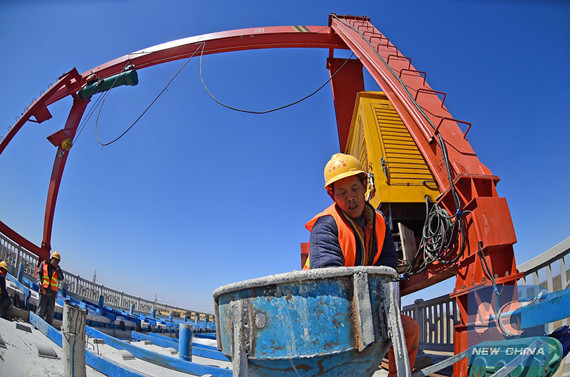
Workers work at the Liaoning section of a high-speed railway in northeast China's Liaoning Province, April 11, 2017.(Xinhua/Yang Qing)
In the latest sign of economic stabilization, China reported better-than-expected growth for the first quarter of 2017.
The world's second-largest economy saw its gross domestic product (GDP) rise 6.9 percent year on year to hit 18.07 trillion yuan (2.63 trillion U.S. dollars) in the first quarter, up from 6.8-percent growth in the previous quarter, according to the National Bureau of Statistics (NBS).
This beat previous market expectations of 6.8 percent and came well above the annual growth target of around 6.5 percent set in this year's government work report.
GATHERING MOMENTUM
NBS spokesperson Mao Shengyong said the economy had achieved a rosy start for this year, attributing the strong performance mainly to robust factory activity, strong consumption and rebounding exports.
GDP was up 1.3 percent on a quarter-on-quarter basis.
"China's economic structure is improving and new momentum is gathering," Mao said, citing strong growth in the service sector and consumption.
Consumption contributed 77.2 percent of the GDP increase in the first quarter. Meanwhile, the service sector rose 7.7 percent year on year in the first quarter, outpacing a 3-percent increase in agriculture and 6.4 percent in the secondary industry. It accounted for 56.5 percent of the overall economy.
For the secondary industry, Mao said sectors such as advanced manufacturing are seeing better-than-average growth, while traditional sectors are also making improvements in quality and technology as the country's supply-side structural reform takes effect.
The job market remained stable, with 3.34 million new jobs created and the surveyed unemployment rate staying under 5 percent, NBS data showed.
STABLE TREND
Mao believes the Q1 data show that China has laid a solid foundation to achieve its full-year economic target, which was trimmed to around 6.5 percent from a range of 6.5 to 7 percent for 2016 to facilitate the country's structural adjustments.
While declining to predict the actual growth figures for the quarters ahead, Mao particularly stressed the increasing stability of China's economic performance and its untapped development potential.
"There will be steady reform dividends and the economy has enormous potential in the medium to long term," he said.
It is "no big deal" if economic growth slips by some tenths of a percentage point in the near future, he said, noting that China's economic growth rate has become less volatile in recent years, with 6.9 percent for 2015, 6.7 percent for 2016 and 6.9 percent for the first quarter of 2017.
Based on the stronger-than-expected data, investment bank J.P. Morgan raised its 2017 GDP growth forecast for China by 0.1 percentage points to 6.7 percent, citing broad-based strength across various sectors reflected in the data.
Though the bank expects GDP growth to ease moderately in the second quarter and even look for some further moderation in following quarters, there is still solid growth momentum for the rest of the year, said J.P. Morgan China economist Zhu Haibin.
OPPORTUNITIES AND RISKS
While still cautious about future prospects, economists believe that the resilience reflected in the first-quarter figure will prompt stricter scrutiny in the financial sector, a move pushed by Chinese authorities to fend off systemic risks.
Authorities who were once concerned that strict regulation would dampen economic growth will no longer hesitate to take stronger measures in financial and real estate controls, said Deng Haiqing, chief economist with JZ Securities.
The higher growth is "important for containing financial risks," which makes the problem of excess leverage look more manageable, according to Tom Orlik, chief Asia economist at Bloomberg.
Looking ahead, Orlik said China's real estate controls will ultimately take a toll on economic growth, and uncertain trade ties with the U.S. could hurt exports.
Mao admitted that the influence of China's property controls will gradually become evident in April and the following months as they were only introduced in mid-March.
"It is fair to say the housing market outlook is a major uncertainty for the economic outlook this year," said Zhu of J.P. Morgan.
Though extreme movements in the housing market are not expected, given the importance of the housing market, even modest upside or downside risks to the housing market could affect the trajectory of growth forecasts, he said.


















































